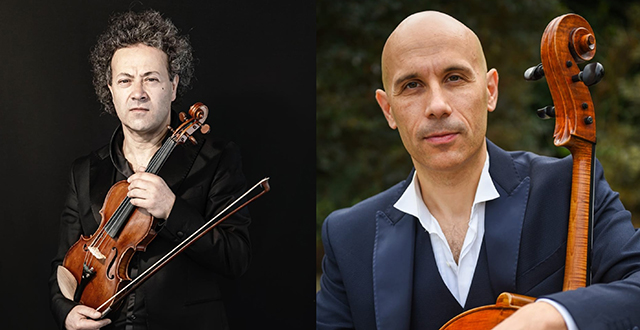“Peace is a blessing for mortals”
Loreto Gismondi, violin
Giuliano De Angelis, cello
Program
R. Glière
8 Pieces for Violin and Cello
Andante, Allegretto, Berceuse, Canzonetta, Intermezzo, Impromptu, Scherzo, Etude
P. Fradiani
Peace Suite
Romance, Divertimento
L. Gismondi
In War and Peace
Andante sostenuto, Elegy, Ostinato
V. Monti
Czardas
G. F. Händel / J. Halvorsen
Passacaglia
Gabriele Mercanti (1988)
Title TBA – world premiere
The Project
The Concert for Peace was born from the shared vision of violinist Loreto Gismondi and cellist Giuliano De Angelis to offer an intimate yet essential reflection on war and violence through music. In today’s global context—marked by numerous ongoing conflicts threatening the fragile balance of peace—the concert becomes a timely and powerful artistic statement.
First performed in 2022 at Memorial Hall in Los Angeles, the program has since featured in leading chamber music seasons across Italy—including the Filarmonica Umbra, Amici della Musica Walter De Angelis in Campobasso, and La Perdonanza in L’Aquila—and is scheduled for performances in Poland, Helsinki, and at the Castel di Sangro Festival.
The concert opens with 8 Pieces by Reinhold Glière, a Ukrainian-born Russian composer. These works weave a seamless dialogue between violin and cello—virtuosic, lyrical, and playful—showcasing perfect balance in both style and voice interplay.
The Peace Suite by Paolo Fradiani, written especially for the Duo, follows. Romance highlights the violin’s expressive potential with a tender melody and richly arpeggiated cello accompaniment, while Divertimento is a brilliant, high-energy 2/4 dance full of dazzling interplay.
At the heart of the program is In War and Peace, an original composition by Loreto Gismondi, written for this project, where he appears as both performer and composer. The work offers a deeply introspective take on the human condition—capturing the helplessness in the face of violence and the silent endurance of something seemingly inescapable.




